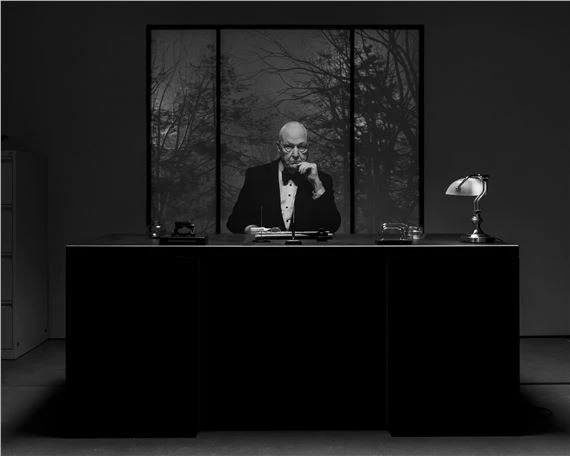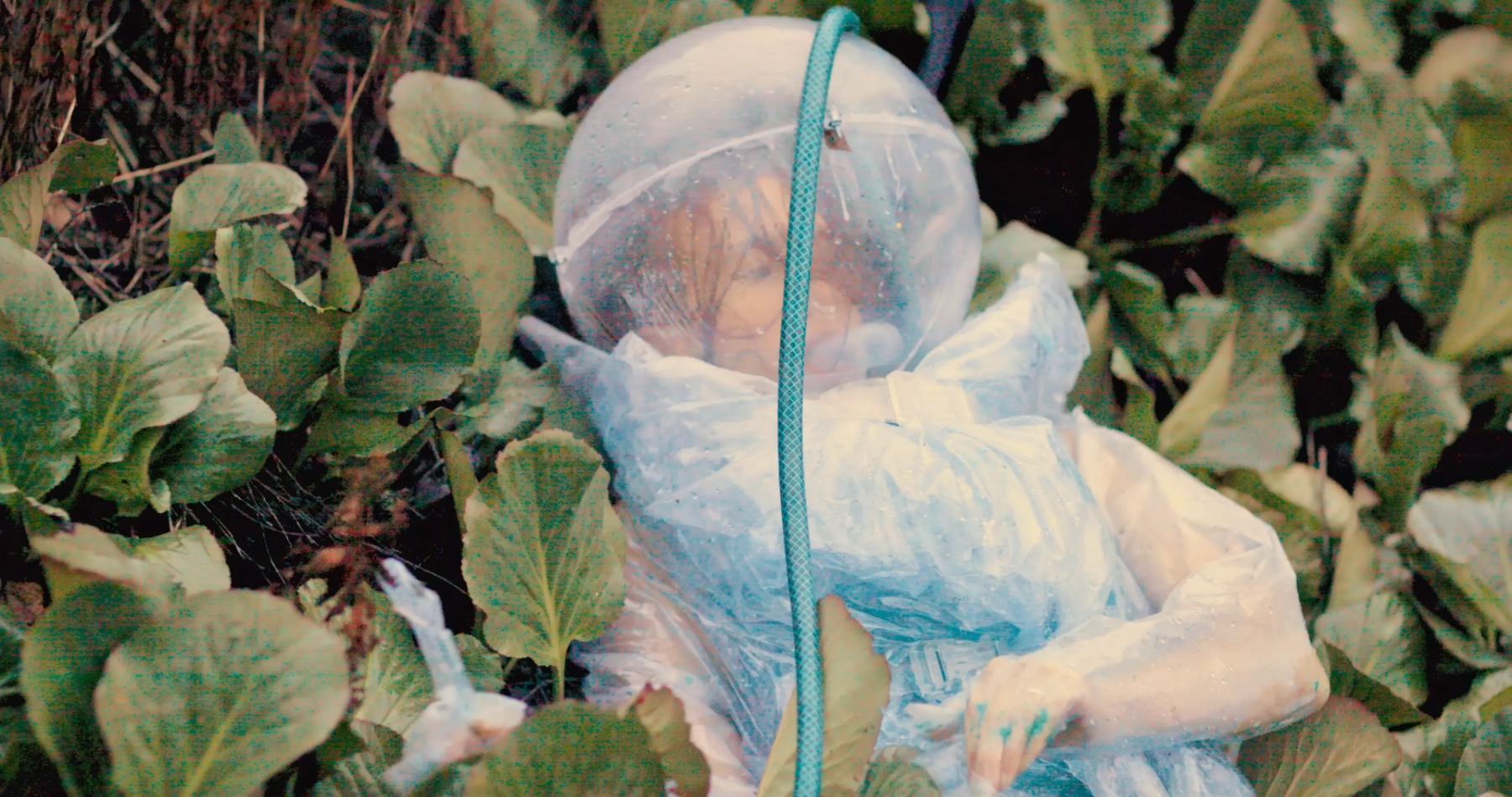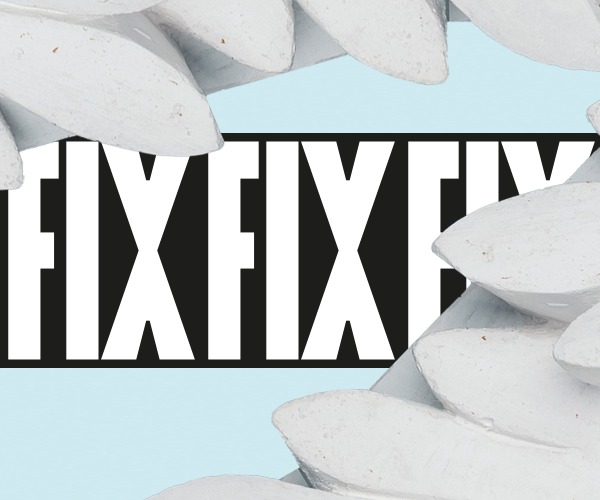
What to see in Scandinavia
Must-see art exhibitions in June-August, 2024
We continue to acquaint our readers with the most relevant contemporary art events of the Baltic region. Our summary of the most interesting exhibitions in the Baltic countries ("What to see in the Baltics"), which we publish bi-monthly, has become a regular feature. However, we are also keen to explore what is happening in Scandinavia, and the exhibitions opening in Poland and Germany. This time we are introducing our readers to a Scandinavian update, which we will publish once a season. So, what do we recommend to see in the summer of 2024?
DENMARK
Copenhagen
Overgaden - Institut for Samtidskunst

Panteha Abareshi: Impaired Erotics
Until 4 August
Panteha Abareshi: OBJECT DESIRE, 2024. Installation view at O—Overgaden. Photo by David Stjernholm
In arresting sculptural gestures, the American artist Panteha Abareshi (b. 1999, they/them) employs the experience of living in a chronically ill and disabled body, and its associated stigma. From their position as a wheelchair user living with an incurable blood disease, Abareshi exposes how the sick body is also one of continuous (medical) observation— and thus objectification. In their new series of sculptural works, created specifically for O—Overgaden, Abareshi, in their own words, unapologetically unfolds “the collision of violence and tenderness in caregiving to the sick body.”
Through braces, belts, straps, and medical tubing, the support and treatment of the body is made visible as a jarring domain of restraint and domination. In brief, Abareshi points to how caregiving, whether in the hospital or the home, can itself contain violence; how systemic, societal “help” also cages and disciplines the sick or disabled body, relegating it to a position of obligatory gratitude and servility, rendering it disempowered in its medicalization and care. The double-edged exhibition title, Impaired Erotics, on the one hand critically examines how the crip body is often misunderstood as one with a broken or “impaired” access to intimacy or “erotics.” On the other hand, Abareshi employs the title as a manifest insisting on an Impaired Erotics—an erotics of the crip body beyond this stigma of inability.
Nikolaj Kunsthal

Super High End Underground
Until 28 July
The group exhibition focuses on the meeting between art and fashion in an attempt to uncover some of the aesthetic trends and activist movements that are currently running through different underground environments in Copenhagen.
Copenhagen is the focal point for a specific creative nerve that connects visual art with avant-garde fashion. Fashion week in Copenhagen twice a year has put the city on the world map, which attracts many visitors to experience the designers' new collections. But where do the designers get their inspiration from? And how do visual artists use fashion in their expression? Super High End Underground focuses on the meeting between art and fashion in an attempt to uncover some of the aesthetic trends and activist movements that are currently running through different underground environments in Copenhagen, for example the rave culture which is reflected in the fashion industry and the contemporary art field. The exhibition examines parts of the mutual inspiration and the dynamic processes that are at play between the fields, permeated by both art and commercialism. In which ways are the artistic expressions overlapping, contrasting and coherent? And what does it say about our current time?
Copenhagen Contemporary
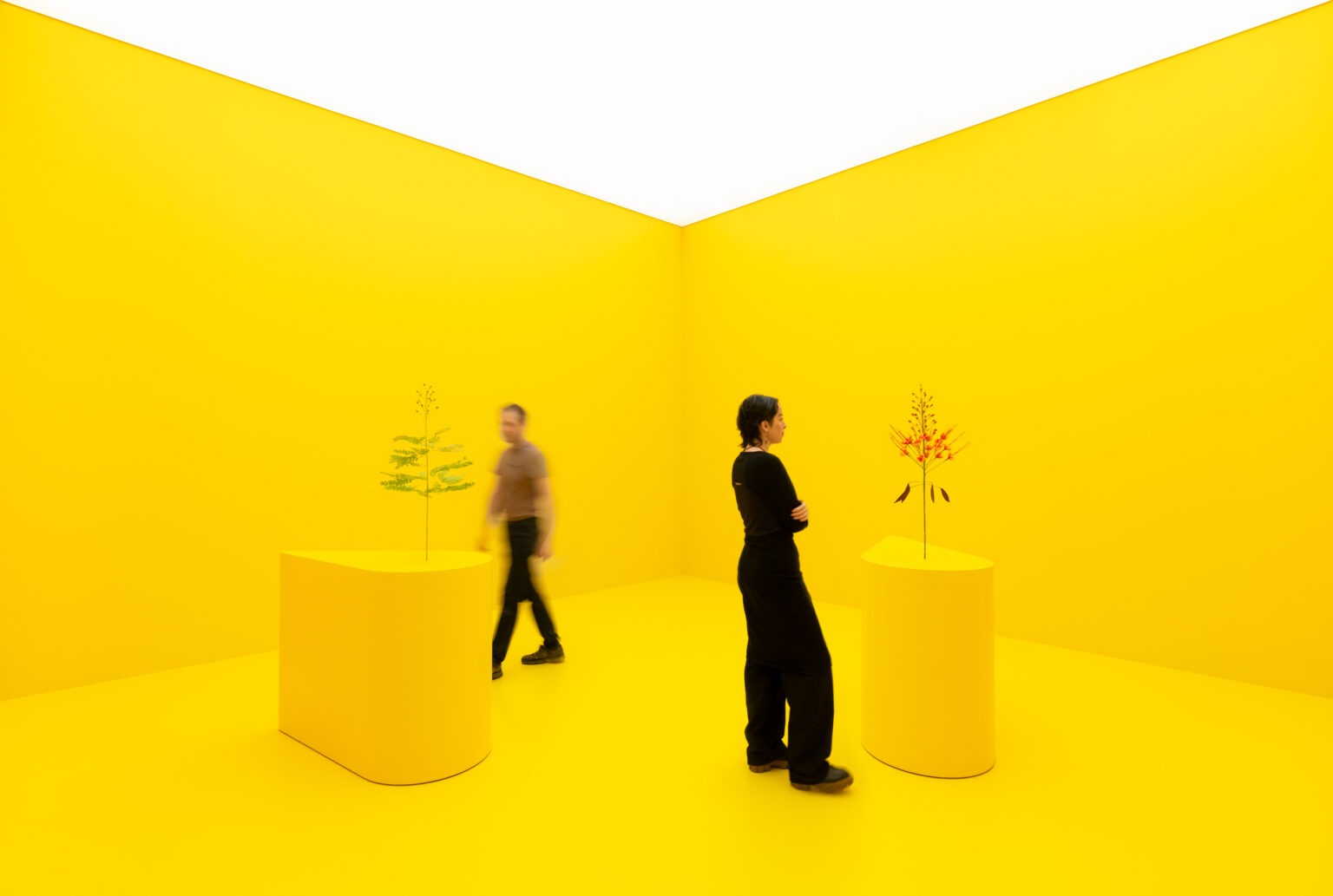
Kapwani Kiwanga: The Length of the Horizon
Until 25 August
Lurking just beneath the surface in Kapwani Kiwanga’s (b. 1978) seductively beautiful works are serious concerns. Plants tell toxic stories of power imbalances and history. Colours contain manipulative effects and light is investigated as a political instrument. In her installations, paintings and sculptures, Kiwanga, who has a degree in anthropology and comparative religion, heightens our awareness of hidden social mechanisms and power structures.
Kiwanga considers the power of colour, light and materials as a way to tell stories with a global outlook. The Length of the Horizon is the first major exhibition in Scandinavia for the artist who has won numerous international awards for her singular body of work. Moreover, Kiwanga has been selected to create the Canadian pavilion for the 2024 Venice Biennale.
Kunsthal Charlottenborg
Thao Nguyen Phan, ‘Reincarnations of Shadows’, exhibition view at Kunsthal Charlottenborg, Copenhagen, 2024. Courtesy the artist and Kunsthal Charlottenborg, Copenhagen. Photo by David Stjernholm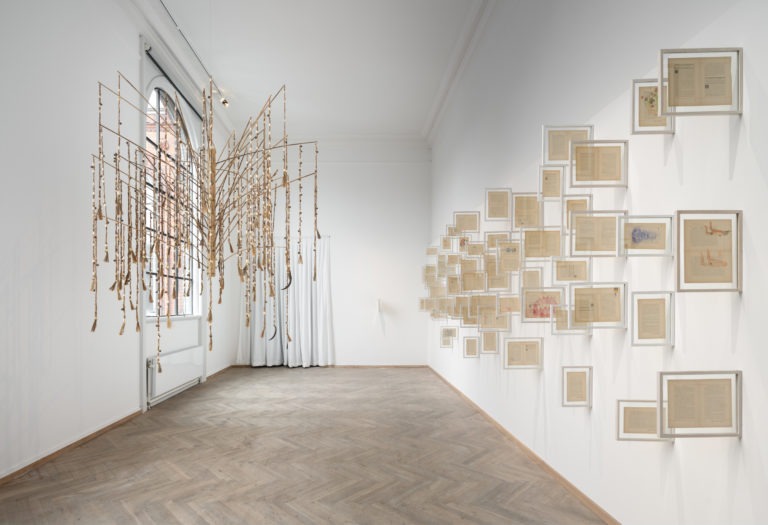
Thao Nguyen Phan: Reincarnations of Shadows
Until 11 August
Kunsthal Charlottenborg presents the first solo exhibition in Scandinavia with Thao Nguyen Phan. The internationally renowned artist intertwines mythology and folklore from her homeland’s turbulent past with current pressing issues of excessive consumption and the destruction of the earth’s resources. The intersection between the documentary and the supernatural take centre stage in this exhibition, which evokes ghostly presences, lush landscapes and unofficial narratives. Thao Nguyen Phan’s spiritual moving image works revolve around the interaction between people, architecture and nature in Vietnam and the broader Mekong region, which has been plagued by natural as well as manmade tragedies throughout history and still to this day is characterized by the legacy of colonialism, ongoing industrialization and increasing climate change.
The exhibition in Kunsthal Charlottenborg’s north wing introduces a deep layering of audio, visual and tactile references. Through more than 100 works from the past 10 years, the exhibition will unfold the artist’s captivating imagery through poetic film installations, meticulously executed lacquer paintings, light sculptures, delicate watercolours and architectural interventions.
Designmuseum Danmark

Danish Modern
14 June – 03 May, 2026
Danish design is known and loved – both at home and abroad. But what led to its success, which designs are central, and who are the major Danish designers of the 20th century? The exhibition 'Danish Modern' unfolds the story of Danish design from the 1920s to the 1970s, focusing on the creation of some of the most iconic Danish design objects.
Danish Modern is an era, a style, a national brand. The style gained popularity in the mid-20th century and quickly became popular in the West. But what lies behind the notions of Danish Modern? In a new permanent exhibition, Designmuseum Danmark explores how Danish designers have methodically worked with design processes and tells the story of the success behind Danish design.
Den Frie Centre of Contemporary Art
Atiéna R. Kilfa: Special Effect
Until 8 September
With Special Effect, Atiéna R. Kilfa presents a new body of works consisting of a short film and two large scale pencil drawings. In continuation of Kilfa’s investigation and restructuring of cinematic archetypes, Special Effect homes in on the nondescript figure of a man sitting at a desk. Shot in black and white, the film eerily evokes a timelessness of the figure by bringing it in resonance with pictorial genres reminiscent of various eras from German Expressionist cinema to the golden age of Hollywood film noir, fast forward to its 4K quality of today. By evoking these archetypes, figuration becomes a tool to examine the ciphers which make up our systems and their potential collapse.
SWEDEN
Stocholm
Moderna Museet
Installation view, The Wicked Pavilion "Vaginal Davis: Magnificent Product". Photo: My Matson/Moderna Museet. © Vaginal Davis 2024
Vaginal Davis: Magnificent Product
Until 13 October
Award-winning artist, acclaimed author and international blacktress Vaginal Davis is coming to Stockholm. In her pioneering and incredibly diverse oeuvre, punk meets glamour, queer activism meets racial justice and resistance meets joy. “Magnificent Product” is her first major solo exhibition. As a leading lady in punk, queer, and Black (art) histories in the United States and beyond, Vaginal Davis has made scenes for a living—from her hometown Los Angeles to her adopted home Berlin. Vaginal Davis: Magnificent Product shows her practice in painting, film, and writing, and how this intersects with her lives as a musician, performer, and organizer.
Following Ms. Davis’s approach to art as a practice that holds no center but emerges from a connected community of people and spaces, as well as a plurality of forms and media, the exhibition Vaginal Davis: Magnificent Product adopts a unique curatorial model and will unfold as a multi-nodal exhibition across Moderna Museet and various institutions in Stockholm, including Nationalmuseum, Accelerator, Index – Swedish Foundation for Contemporary Art, Tensta Konsthall, and MDT. The collaborative impulse behind this project is informed by both an insistence on the multiplicity of Ms. Davis’s practice and a desire to host communities in different ways and in different spaces—indeed, to envision the exhibition as a heterogeneous platform where an audience can become a community across various spaces in a city.
Maurizio Cattelan, La Nona Ora, 1999. Photo by Zeno Zotti. © Maurizio Cattelan 2024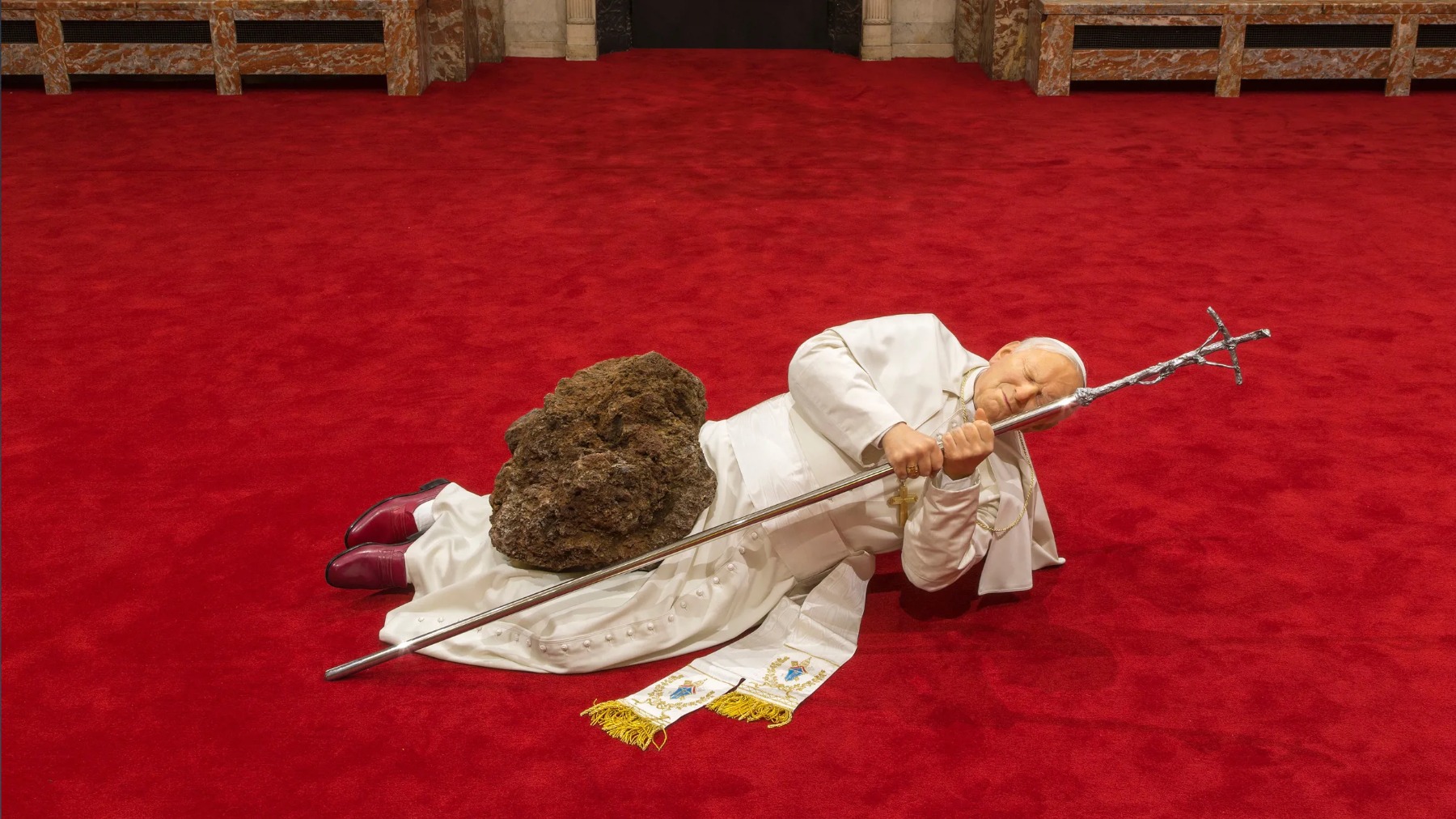
The Third Hand. Maurizio Cattelan and The Moderna Museet Collection
Until 12 January, 2025
Who has the power over art, society, life, and death? Using satire and humour, provocation and seriousness Maurizio Cattelan, questions the conventions of society in general and the art world in particular. The exhibition “The Third Hand” includes several of Maurizio Cattelan’s most iconic works alongside pieces that he has chosen from the Moderna Museet Collection. Born in Italy in 1960, Maurizio Cattelan has been living in New York for the past thirty years. The scrutiny of power and belief systems is a theme that runs through his entire body of work but he leaves the interpreting of his artworks to the viewer:
A pope is struck down by a meteorite, pigeons watch us from above, a shrunk Sistine Chapel lets us see all the amazing details at eye level, a dictator becomes a pathetic figure, perhaps asking for forgiveness, a monumental fascist greeting is nullified by missing fingers, a man and a dog seem to share a common dream or death… The exhibition’s title is open to interpretation. Perhaps it is Maurizio Cattelan himself who is the third hand, who inserts himself between the institution Moderna Museet and its collection to interrogate and shine a critical light: Which art should be part of a collection? Which works should be exhibited? What or who decides what is important art?
Nationalmuseum Sweden
Minä perhonen, rain track from spring- summer collection 2019. Model: Aoi Yamada. Photo: Yayoi Arimoto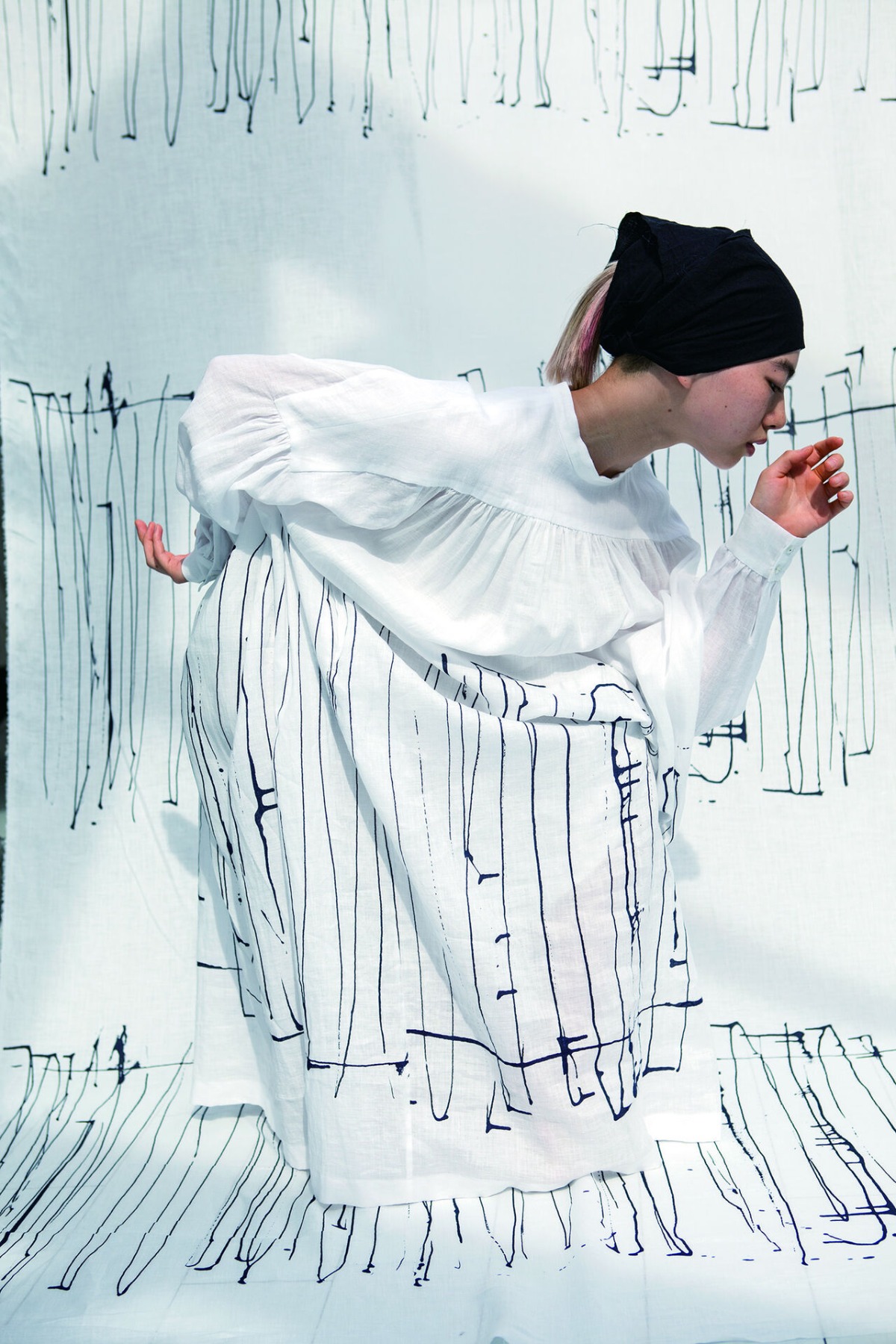
Design=Memory. Akira Minagawa & Minä perhonen
“Design creates emotion. Emotions become memories. From memories come ideas, ideas return to design – I believe that design and memory are in a single cycle, and that each is the same energy in a different state.“ This is how Akira Minagawa describes the core idea, the circular flow, related to the forthcoming exhibition Design=Memory that will be shown at Nationalmuseum from February 2024 onwards.
Akira Minagawa is one of the most prominent Japanese designers and the founder and lead designer of fashion and textile brand Minä perhonen. Minä means I in Finnish, and perhonen means butterfly. The company started in 1995 as a one-man operation but grew gradually into the team of 200. The sphere of Minä perhonen’s creative activities has expanded from fashion to home décor, tableware, and eventually, to all aspects of daily life. Minä perhonen has a long track record of international design collaborations with companies such as Artek, Kvadrat and Iittala as examples, and in Sweden with Klippan.
Fotografiska Stockholm
Eli Eli: Oceanic Feelings
Until 18 August
Swedish choreographer and multi-artist Eli Eli is the next rising talent to exhibit their work as part of Fotografiska’s Emerging Artist initiative. Oceanic Feelings opens on May 9 with projections and textile works.
“Eli Eli’s exhibition is frightening, beautiful, playful, and solemn all at once,” Lisa Hydén, Director of Exhibitions. Oceanic Feelings consists of works from two of Eli Eli’s series, The Watersuit and Human Anatomy. While visitors step into a playful room, the focus is on a serious topic: the impact of the climate crisis on the oceans. Eli Eli studied choreography in Amsterdam and has exhibited in Stockholm, Gothenburg, and Malmö. They have also been artistically active in several other countries and are known for their conceptional and multidisciplinary artwork that often sparks discussions and piques the imagination.
”The exhibition title Oceanic Feelings refers to a philosophical concept about the dissolving of the ego and a sense of belonging to something greater. While this interconnectedness entails responsibility, it is also amazing to image yourself as part of a constellation in an increasingly self-centered and isolated West,” says Eli Eli.
Liljevalchs
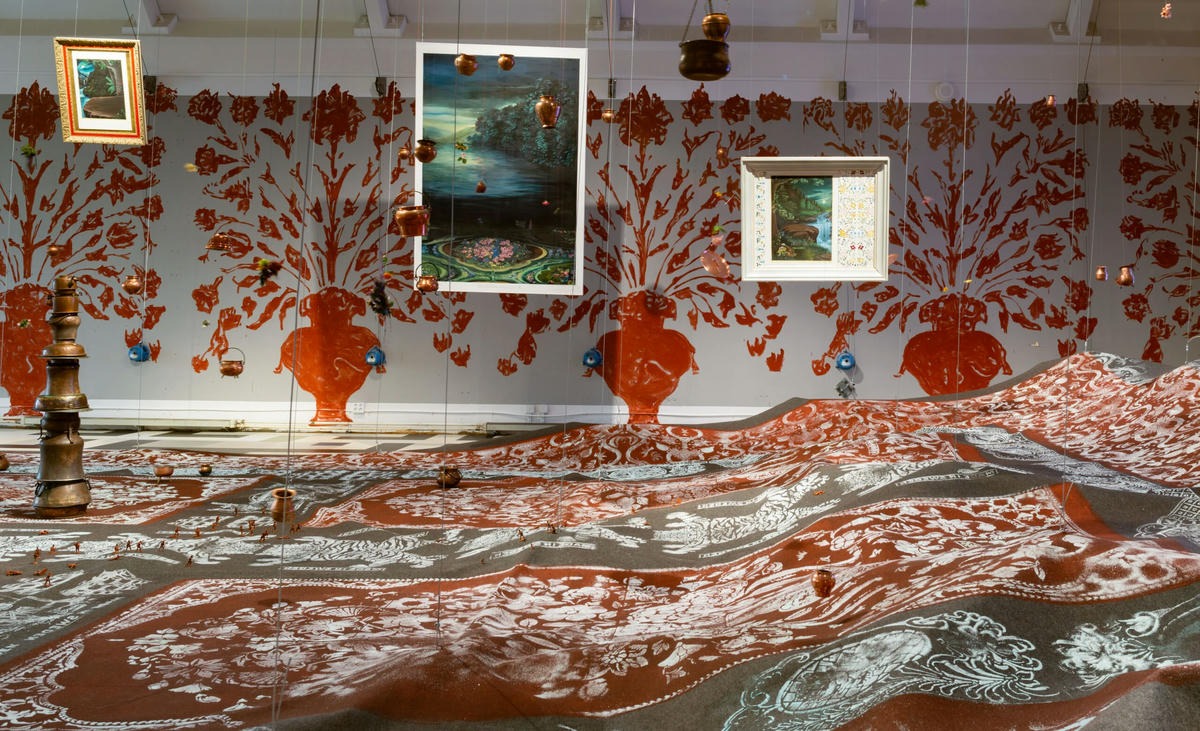
Stockholm Cosmology
14 June – 18 August
For the first time, Stockholm's globalized art scene is presented on a large scale. Stockholm's cosmology puts a magnifying glass to the question of what forces and experiences make an art scene richer. At the center is an expanded painting that uses a variety of materials to convey experiences that flow through, from and to Stockholm.
Participating artists: Ailin Mirlashari, Anna Camner, Ayan Farah, Laercio Redondo and Birger Lipinski, Cecilia Ömalm and Göran Östlin, Marc Johnson, Martin Gustavsson, Muhammad Ali, Munish Wadhia, Olof Inger, J.G. Arvidsson, Santiago Mostyn, James Webb and Susanna Marcus Jablonski (in dialog with Anders Årfelt).
FINLAND
Helsinki
HAM, Helsinki Art Museum
Nastja Säde Rönkkö. Photo: HAM / Maija Toivanen.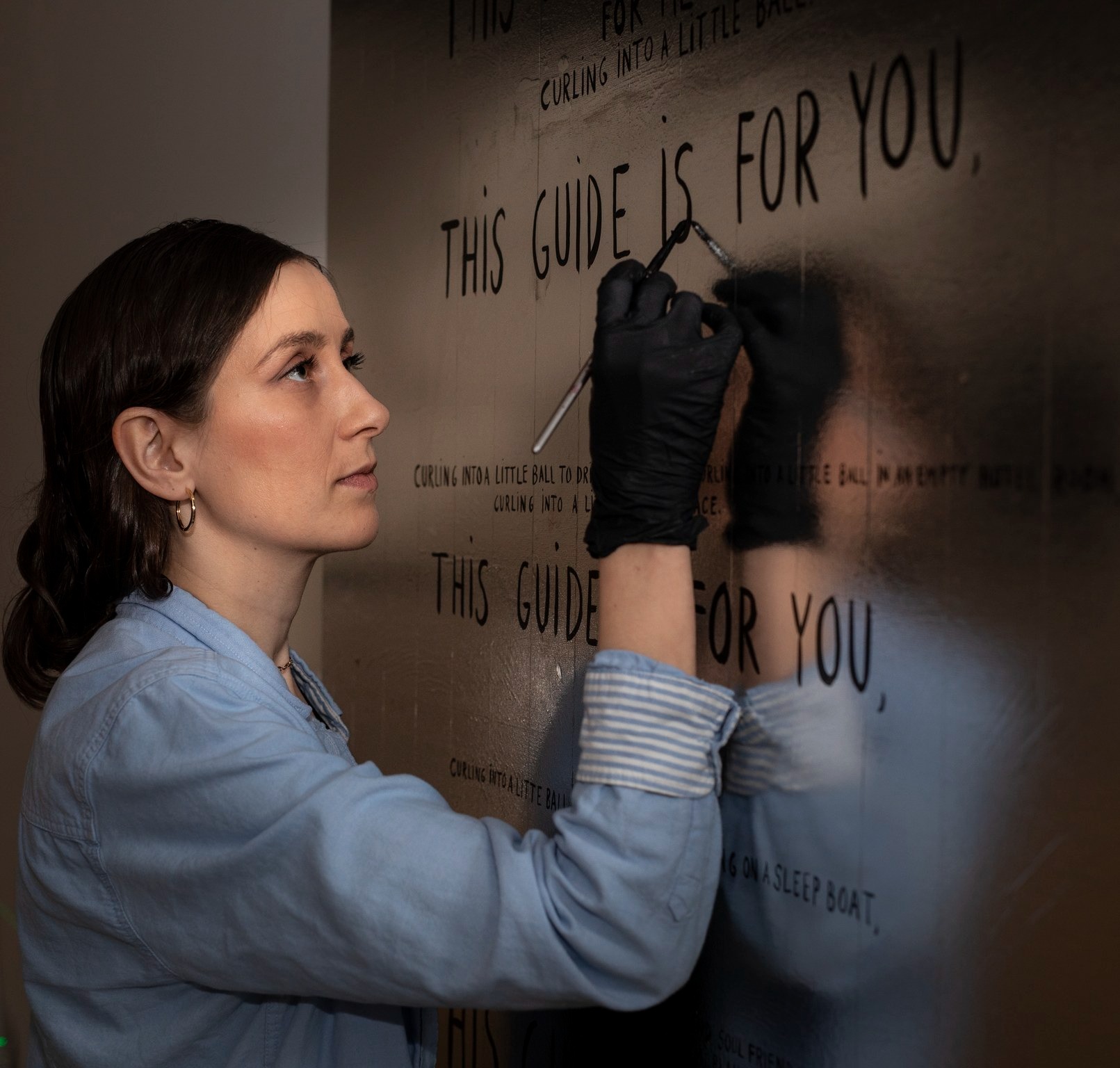
Nastja Säde Rönkkö: Survival Guide for a Post-Apocalyptic Child
Until 8 September
Nastja Säde Rönkkö’s thought-provoking installation invites viewers to reflect on the uncertain future facing humankind and all living beings. At the core of the work, 26 videos examine strategies for crisis survival. “Survival Guide for a Post-Apocalyptic Child was created for everyone living in this era of radical social upheaval, climate change and inner transformation. The underlying idea behind the piece is that an unstoppable chain of events affecting all life on Earth has already begun. An irreversible political, social or environmental chain reaction has thrust us into the midst of a world-changing event. What should we remember about the present era? What should we learn and pass on? How can we dream up new ways of living?”– Nastja Säde Rönkkö
Filling one of HAM’s upstairs grand arched galleries, the videos are narratives about loss, longing and the last moments of civilization as we know it. Proposing strategies for coping with both the physical and emotional challenges of our planet’s impending breakdown, the content of the videos varies from practical nutrition tips for roamers lost in the forest to speculative imagining of worlds on other planets. The material gains personal relevance situated both against today’s global crises and individual emotional experiences.
Eeva-Leena Eklund: Pim, 2003. HAM Helsinki Art Museum. Photo: Yehia Eweis
Who Is an Animal?
Until 18 August
Who Is an Animal? invites audiences to reflect on a subject that is identifiable yet ultimately a mystery. The exhibition explores art’s ability to help us understand the challenges of coexistence, human-imposed hierarchies and the commonalities that unite humans and other living beings. The animal kingdom has intrigued artists through the ages, and animals are among the oldest classic subjects in Western art. Curated mostly from Helsinki’s City-owned art collections, Who is an Animal? features 91 works by 48 artists, including photographs, videos, paintings, sculptures, graphic art and installations spanning from the late 19th century to the present day.
The exhibits are grouped thematically under animals as individuals, challenges of coexistence with humans, altered habitats and animal agency. Animals are spotlighted with warmth and humour in this exhibition curated by HAM’s curator Sanna Juntunen. The human claim of superiority over other species has resulted in accelerated biodiversity loss and other drastic consequences. Many artists today are questioning and exposing the specious nature of human-made hierarchies. Although we cannot escape the limitations of being human, we can foster hope of a fairer coexistence through speculative imagining, radical empathy and acceptance of species equality.
Kiasma, Museum of Contemporary Art
Nina Beier, China, 2015. Photo: Finnish National Gallery / Petri Virtanen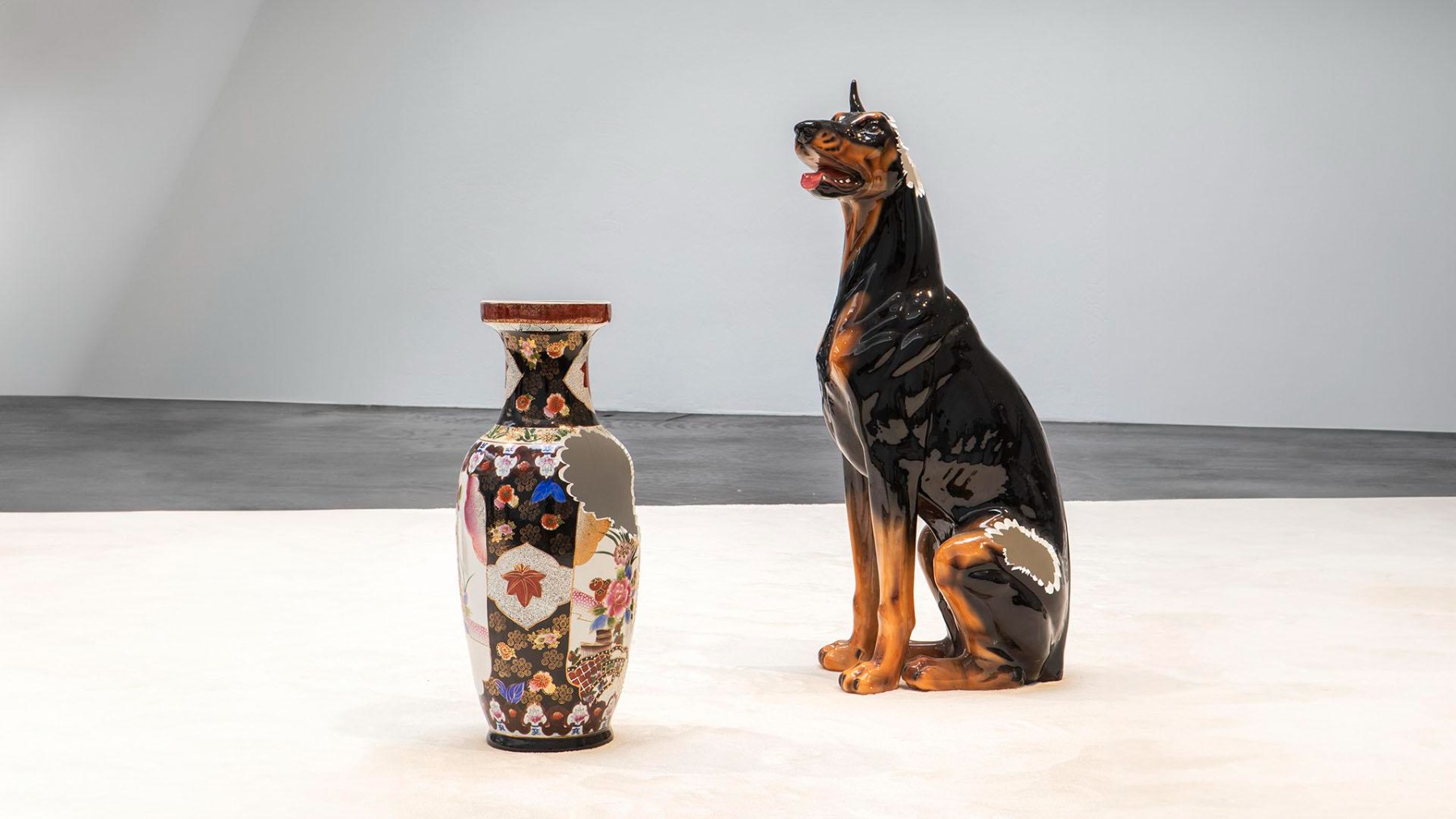
Nina Beier
Until 8 September
Nina Beier turns the spotlight onto the biographies and historical baggage that many everyday items carry with them. Her sculptures are often based on existing objects that she uses as mirrors to reflect the world around them, its power structures, flows of materials and money, and the endless meanings associated with merchandise. Remote-controlled toy cars carry human-hair wigs. The plugholes in old sinks are blocked with cigars, and porcelain dogs are paired with porcelain vases. Nina Beier uses existing objects and materials in her works. She creates juxtapositions, producing a tangled dialogue or confrontation between the many meanings they carry. Beier is interested in the biographies of objects and the journeys they make from unprocessed matter to commodities and goods. Objects are manufactured, transported from one continent to another, copied, bought and sold. The raw materials come from somewhere – the earth, an animal, or even a human being. In this way, all objects are bound up with the global economy and with inter-personal and inter-species power relations. Beier collects objects that have been shaped cumulatively over the course of time and place. Along the way, they acquire symbolic value, which is renegotiated over time.
Beier is interested in the biographies of objects and the journeys they make from unprocessed matter to commodities and goods. Objects are manufactured, transported from one continent to another, copied, bought and sold. The raw materials come from somewhere – the earth, an animal, or even a human being. In this way, all objects are bound up with the global economy and with inter-personal and inter-species power relations. Nina Beier (b. 1975, Denmark) works in Copenhagen. This is her first solo exhibition in Finland and the most extensive survey of her work in the Nordic countries to date.
Kaarlo Stauffer. Unttitled. 2014. Finnish National Gallery. Photo: Finnish National Gallery / Pirje Mykkänen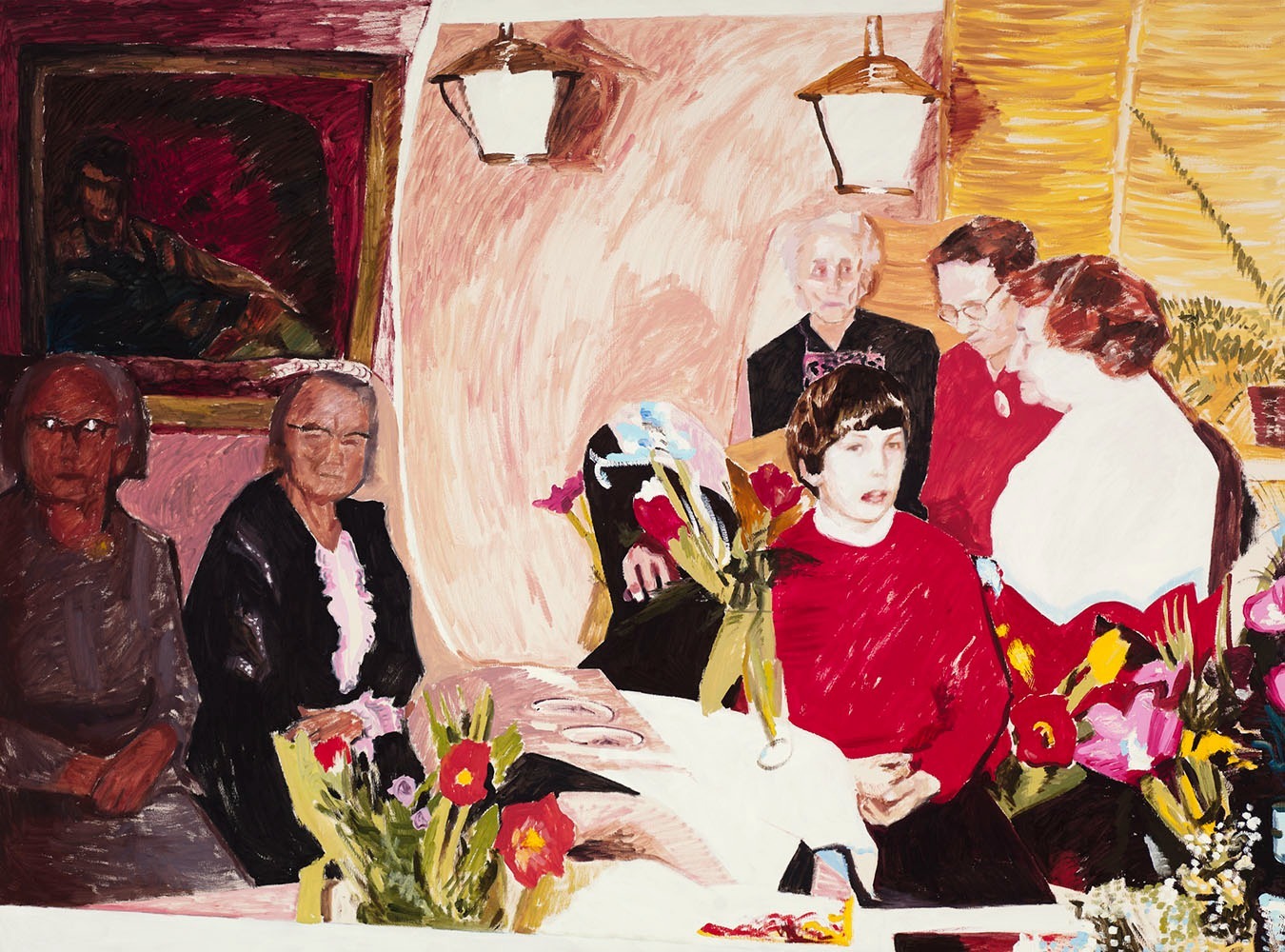
Feels Like Home. Kiasma's Collection Exhibition
Until 12 January
The need to belong is shared by many. How is the sense of belonging reflected in identity, our relationship with other people, and more broadly in society? Featuring a selection of works from the museum collection, the show investigates belonging from a variety of perspectives: How do people connect with each other and their environment? The experience of belonging can also be marked by nostalgia for the past or for a place that has been left behind. Some of the works in the show examine the impacts of migration. An individual’s sense of belonging can be undermined or strengthened by nationality, state, or language. The works reach out not only to the past but to the future as well: What are the worlds we dream of?
The exhibition also shares experiences of how it feels when home is lost or far away, whether by choice or force of circumstance. War and exile can sever ties with loved ones and beloved places. Loss and longing can be passed down through generations. As the artworks show, individual experiences are intertwined with social change and broader historical events. Home and belonging are important topics of discussion in today’s Finland. Many of us are touched on a personal level by migrations and diasporic transitions. Finland has grown more diverse, and Finnish artists, too, come from a growing variety of cultural backgrounds. A museum is a place for coming together and understanding each other, and art can offer a means of understanding the past and imagining the future.
Read also our express interview with a curator Saara Hacklin about the exhibition Feels Like Home at the Museum of Contemporary Art Kiasma (Helsinki)
Amos Rex
Henni Alftan: Darling, 2014. Photo: Stella Ojala / Amos Rex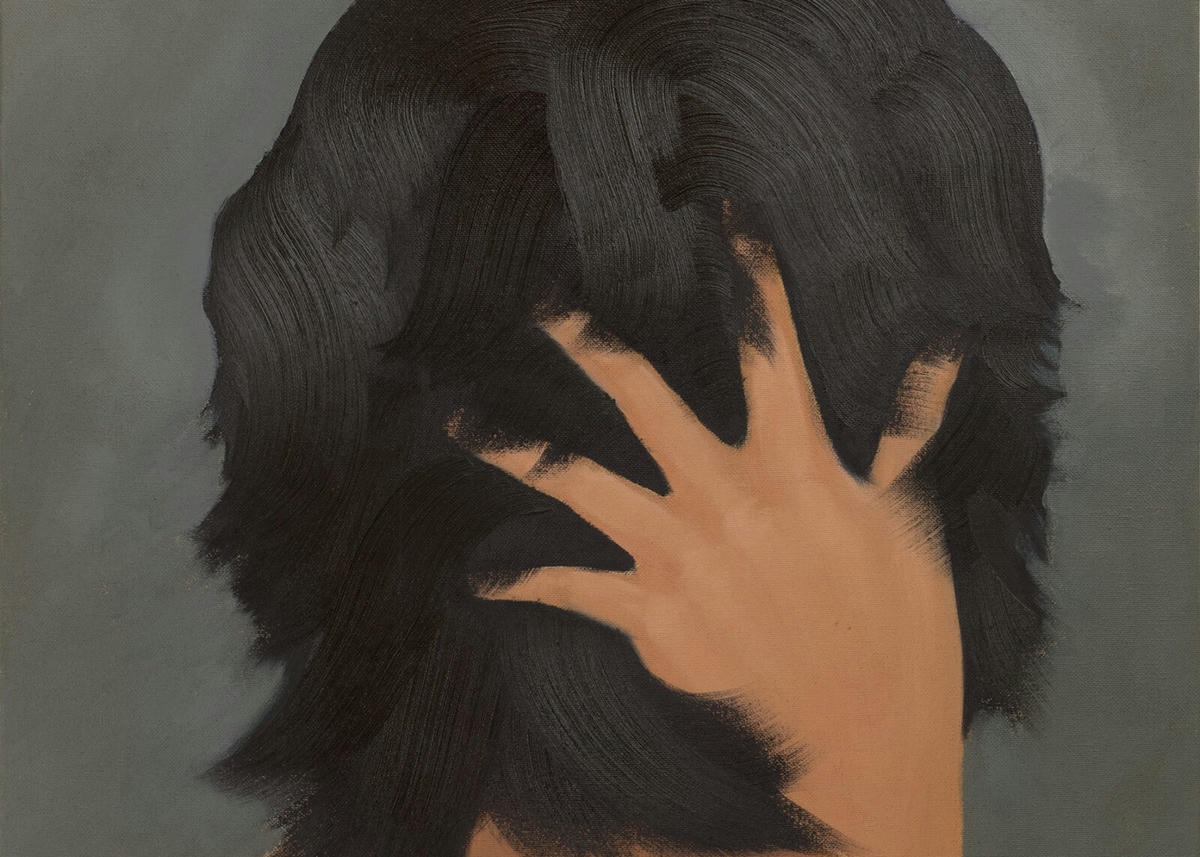
I feel, for now
Until 8 September
Art moves us, or not, in ways that we ourselves do not always quite understand, let alone know how to put them into words. I feel, for now is Amos Rex’s first exhibition of works from its own collections on this scale and takes us through the art into emotions. The more than a hundred artworks chosen for the exhibition carry us from isolation to empathy, from ecstasy to nostalgia. The title of the exhibition refers not only to Kari Cavén’s ambiguous artwork with the same name (1990), but also to the fluidity and transient nature of emotions. The five themes of the exhibition are intertwined with diverse emotions, but also with each other. We traverse from subterranean, repressed mental landscapes through the spirituality kindled by art, into nostalgia, the verbal expression of emotions, and the atmosphere shaped by the mediation of materials and different senses. Visitors are invited to create their own routes through the exhibition, with any emotions they experience along the way never being either right or wrong.
Föreningen Konstsamfundet’s art collection is managed by Amos Rex and comprises more than 6 000 works. It is based on the body of some 400 artworks built up by the businessman, newspaper publisher and patron of the arts Amos Anderson (1878–1961). His home museum, Amos Andersons Hem – opened on Yrjönkatu Street, Helsinki, in spring 2023 – and Söderlångvik Museum on Kimito Island both house permanent displays of mostly older works from the collection. The extensive and vast exhibition at Amos Rex art museum presents over 100 artworks from 76 artists, extending from the 1960s to the present day. Art works include painting, installation art, sculpture, video art, photography and sound art.
Design Museum
FIX: Care and Repair
Until 31 December
The joint exhibition FIX: Care and Repair at the Museum of Finnish Architecture and the Design Museum focuses on repair and maintenance while also exploring how the passage of time affects architecture and design. Objects and buildings undergo constant change. They age, get dirty, and break. Maintaining and repairing things are active practices that reflect our prevailing values. What objects and things do we invest time and money in caring for? What is left outside the scope of care? Maintenance-related work often takes place out of sight. The FIX exhibition places everyday tasks at the center of wonder. The exhibition features selected examples from the fields of architecture and design, along with four newly commissioned contemporary art installations. In their works, contemporary artists contemplate our relationship with dirt, power, and the seemingly mundane choices we make.
Designer Lauri Johansson’s exhibition architecture, complete with plasterboard, also alludes to an ongoing renovation. It serves as a reminder that our shared world is never finished but constantly requires maintenance. Visitors are invited to contemplate questions of repair, cleaning, and upkeep, and to participate in events woven around the exhibition.
NORWAY
Oslo
The National Museum in Oslo
Mark Rothko, Untitled, 1969, National Gallery of Art, Washington, Gift of The Mark Rothko Foundation, Inc., 1986.43.275 © 2023 Kate Rothko Prizel & Christopher Rothko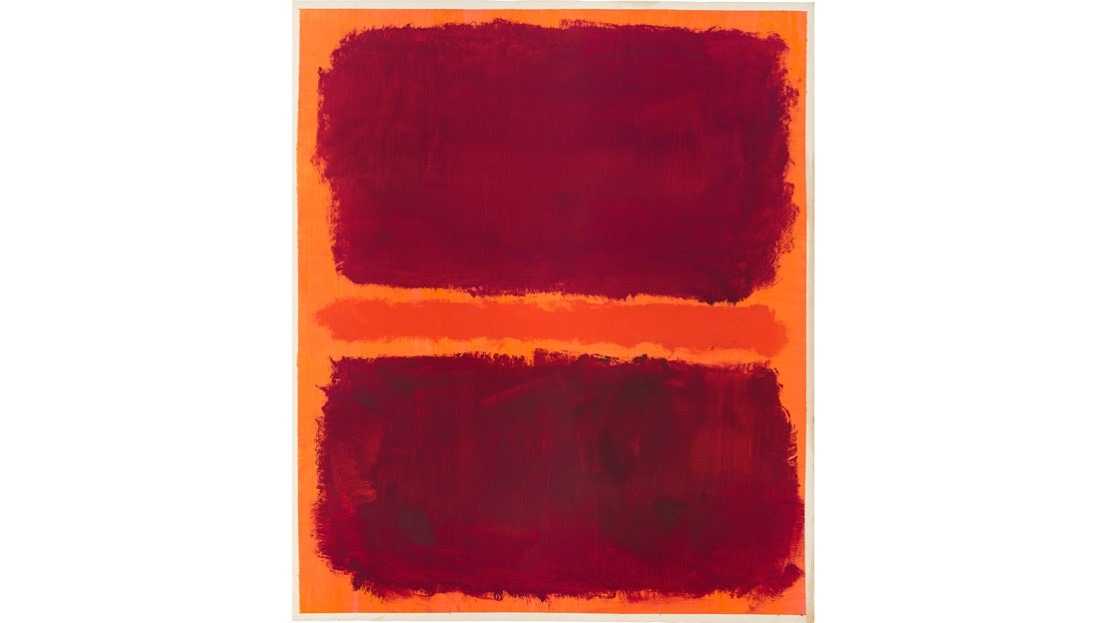
Mark Rothko. Paintings on Paper
Until 22 September
Mark Rothko’s luminous paintings revitalised abstract art and made him one of the most important artists of the last century. With nearly 80 works, the exhibition at the National Museum will be the first major presentation of Rothko’s work in the Nordic region. Tragedy, grief, ecstasy and joy are some of the themes Rothko strove to express. He became best known for his immense abstract paintings on large canvases. Less well known is that he also painted some 1,000 works on paper. The paintings on paper convey a side of Rothko’s art that has only recently begun to receive serious attention. They challenge established notions of what is and is not a painting. The themes range from landscapes, portraits and surrealist projects to Rothko’s characteristic, rectangular color fields.
Vasily Kandinsky. Three Riders in Red, Blue and Black (Drei Reiter in rot, blau und schwarz). 1911 ©Centre Pompidou, Hervé Véronèse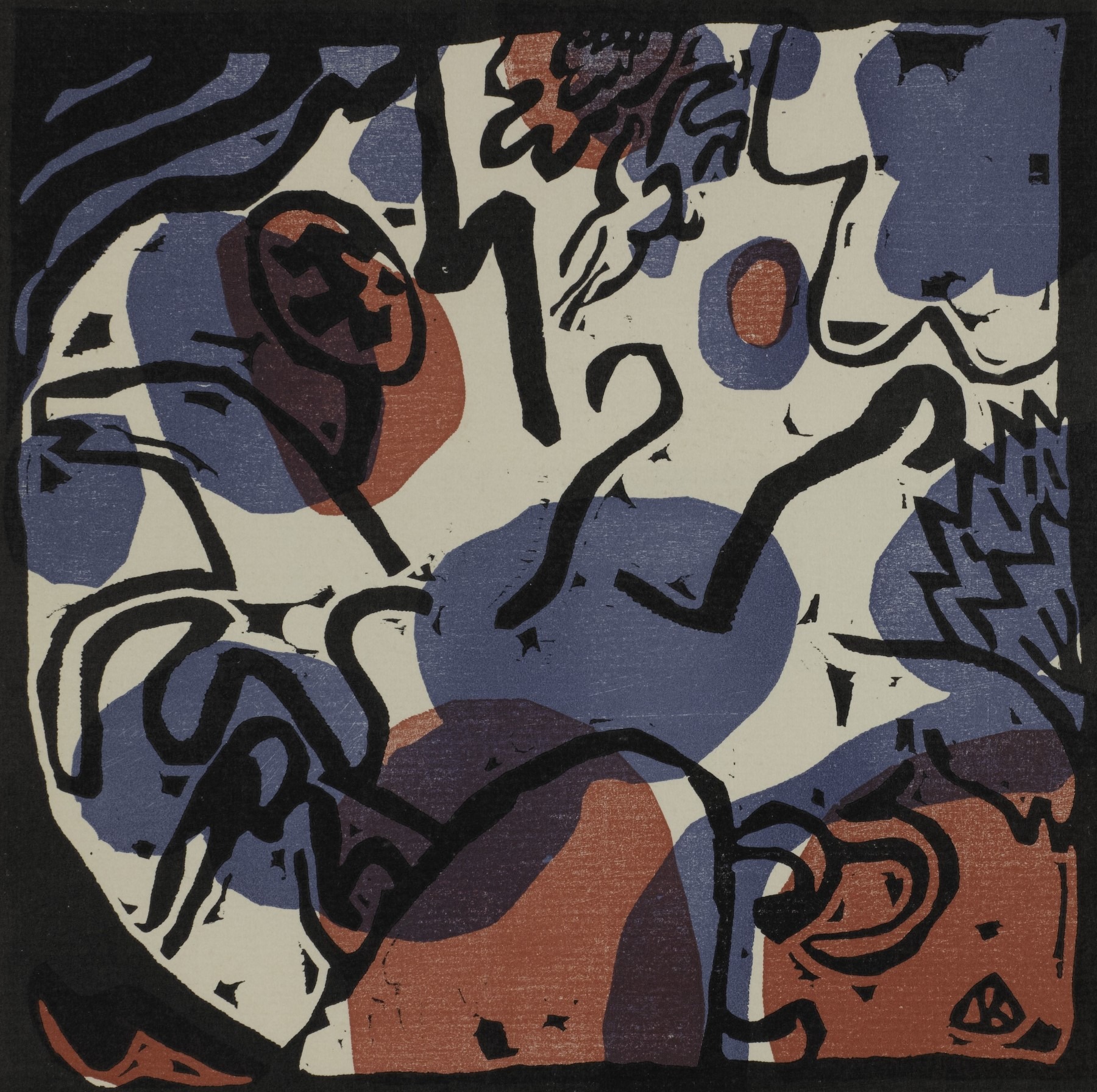
Kandinsky. Into the unknown
Until 18 August
Vassily Kandinsky was central to the development of modern art in the 20th century. This exhibition focuses on a less familiar phase of Kandinsky’s art, with works from his early career. Especially in his prints, Kandinsky experimented with form, colour and line, laying the groundwork for the abstract idiom that would later make him famous. With works that have never been shown in Norway before, this exhibition is a unique opportunity to explore a lesser-known aspect of Kandinsky’s art.
In 1896, Kandinsky saw Claude Monet’s painting "Haystacks" in an exhibition of French impressionists in Moscow. That same year, he saw a production of Richard Wagner’s opera "Lohengrin". Deeply impressed by both experiences, Kandinsky decided at the age of thirty to travel to Munich to become an artist. In Munich, he worked extensively with printmaking, especially with xylography, woodcut, and linocut techniques. These are media that invite simplification of surface, form, and line, and Kandinsky’s exploration of the processes gradually led him to a more symbolic and abstract idiom. You can see several of his works from this period in the exhibition. The exhibition is based on a loan from the Centre Pompidou in Paris and has been developed in collaboration with curator Anne Montfort-Tanguy.
Astrup Fearnley Museet
Cauleen Smith, The Deep West Assembly, 2024, Film still © Courtesy of the artist. Photo credit: Mar Sudac.
The Deep West Assembly. Cauleen Smith
14 June – 15 September
Since releasing her first feature film in 1998 after an early education in music, American artist Cauleen Smith has produced experimental films and video installations for audiences in the film and art worlds for over two decades.
A shoot, show, or performance by Smith encompasses improvisation with those being filmed and generates future-focused, novel arrangements of physical objects, projections, textile banners, live musical performances, and with them, new experiences of Black social life. Within the multi-room exhibition Smith is premiering a new film commissioned by the Astrup Fearnley Museet. A program of Smith’s films will screen in a cinema for the first time in Norway in a partnership between Astrup Fearnley Museet and Cinemateket.
Kunstnernes Hus
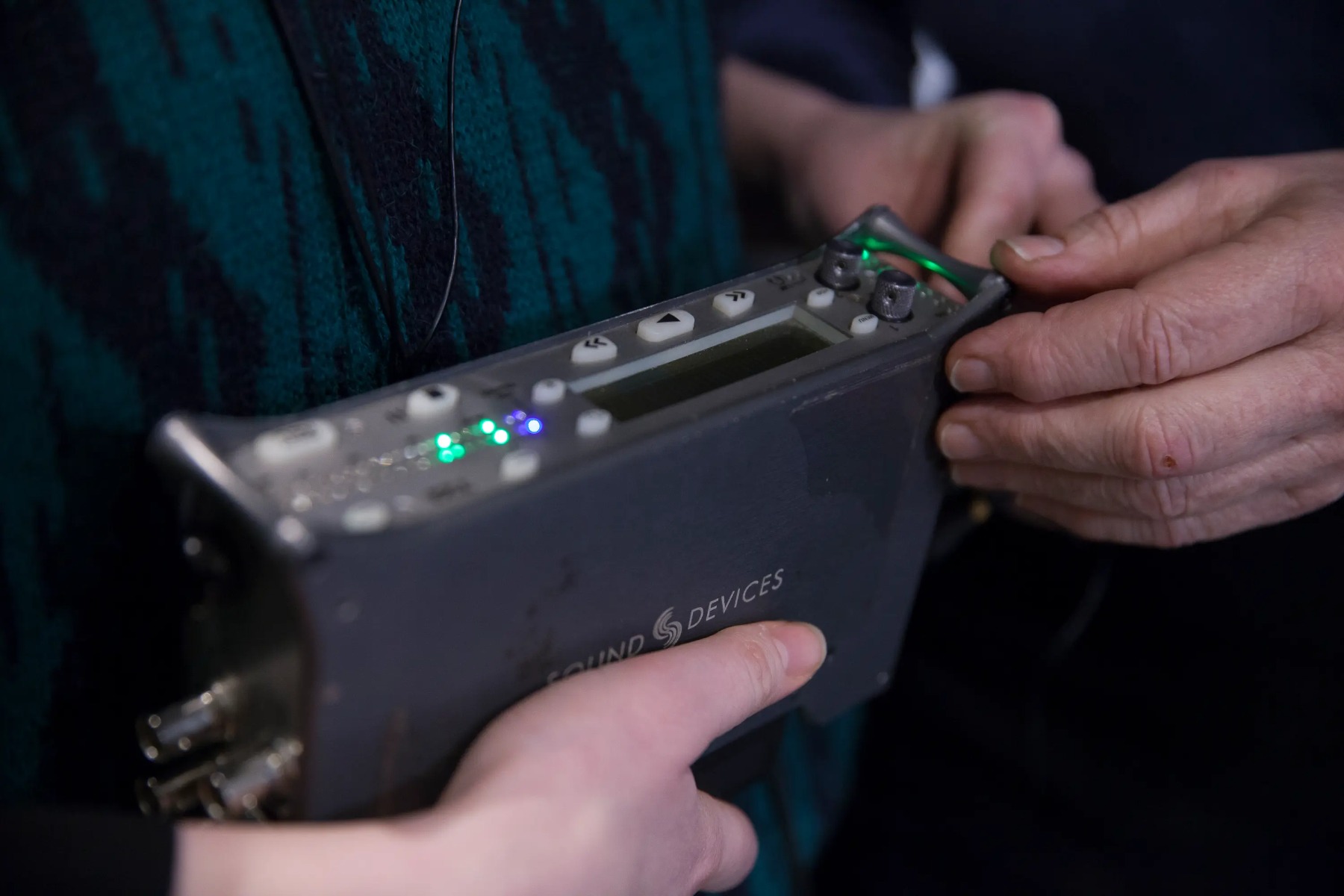
Maia Urstad: Do You Hear That Whistling Sound?
24 May – 04 August
Maia Urstad’s exhibition invites us into a soundscape that is both familiar and unfamiliar. We are surrounded by signals and voices that range from beneath the ocean surface, to the terrestrial planes we inhabit, and extending far into the universe. For the artist, these human-generated blips, beeps and communications are time markers in our collective sound history. The sounds are abstracted and processed by the artist into an immersive composition created in and for the skylight hall.
Taxi radios in Buenos Aires, calls to prayer in Ramallah, street protests in Santiago de Chile, wind on islands off the West Coast of Norway, the Oslo tram... Urstad's range is global. For years, she has collected sounds from a multiplicity of sources. Through site-specific sound works and installations, she sends signals out into the world and draws connections backward in history and forwards in time. She is consistently interested in the invisible communications that occur in our radio spectrum and technologies from our recent past that enable communication over long distances, such as radio and telecommunications. The radio has been a preoccupation, both sonically, visually, and conceptually, in a series of Urstad's sculptural installations. In recent years, she has also collaborated with amateur radio operators who communicate via the ionosphere. With the exhibition at Kunstnernes Hus, the artist encourages us, through a vertical journey through the acoustic layers of our sound universe, to reflect on technological development and the auditory traces and imprints we leave behind.
Vestfossen Kunstlaboratorium
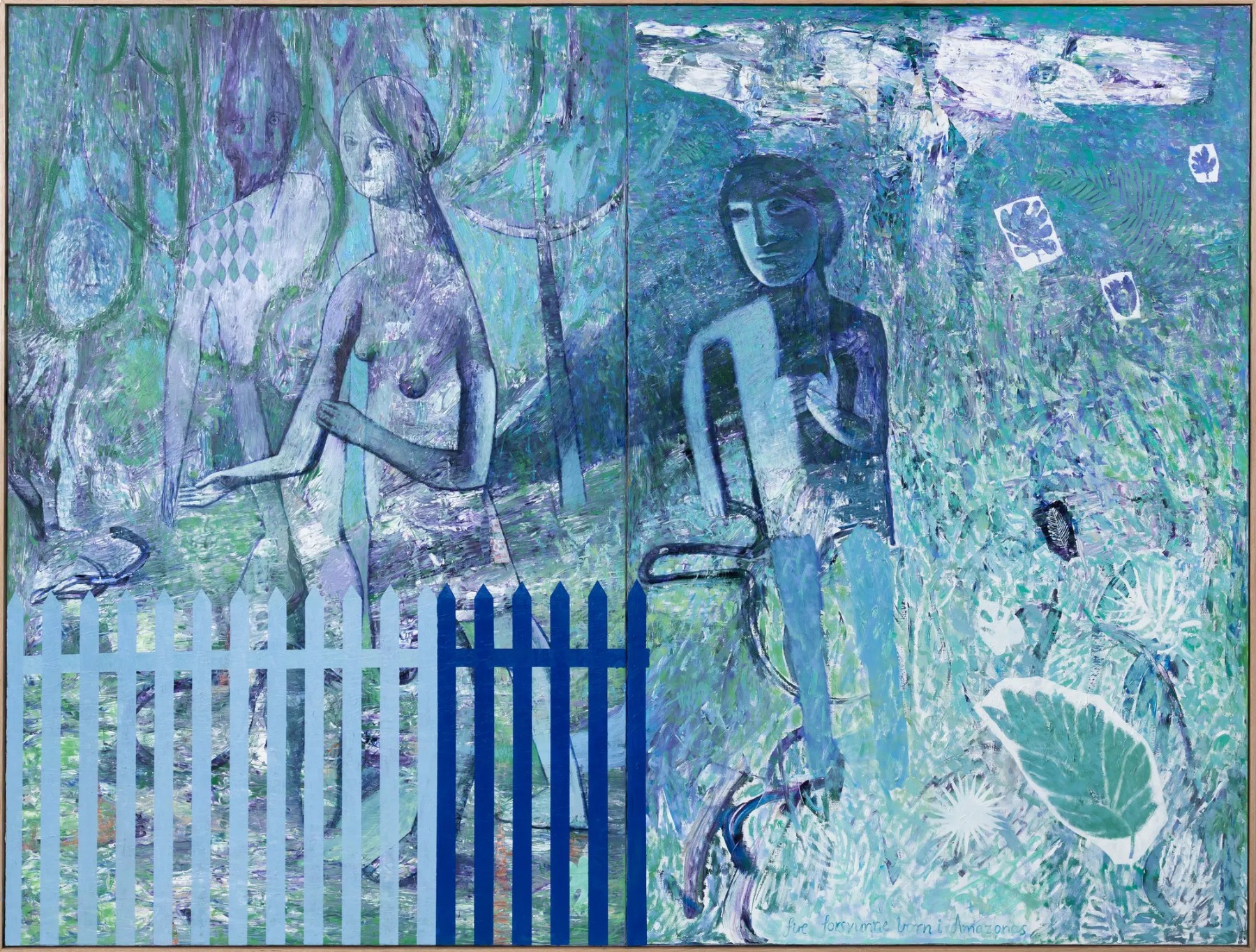
Sverre Bjertnes: Hjem
04 May – 22 September
Hjem (Home) is a broad presentation of the work of Sverre Bjertnæs, comprising around 40 paintings and sculptures, old and new, of varying sizes and quality, all put together by Fredrik Værslev in the spring of 2024.
The exhibitions in the Main Building have, across the years, varied between curated thematic exhibitions, exhibitions drawn from collections, and geographically oriented exhibitions. This year, for the first time, main exhibition is dedicated to the work of a single artist – all four floors of the Main Building will be filled with the art of Sverre Bjertnæs. Bjertnæs is one of Norway’s foremost painters and sculptors.
Line Larsen, the artist formerly known as VIRG ‘Modern Art Makes Me Angry’ (2014)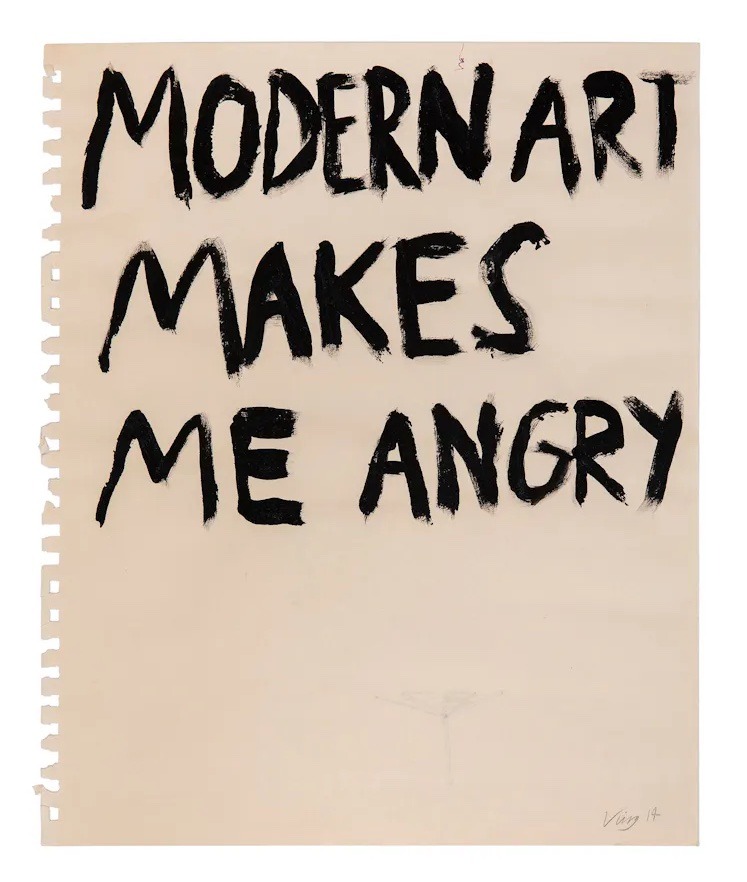
VKL Collection
04 May – 22 September
As early as the first years of Vestfossen Kunstlaboratorium, one of the ambitions for the institution has been that it would build its own art collection. This year, on the mezzanine of the Main Building, parts of this collection are being shown for the first time as a separate exhibition.
The VKL Collection ranges from artists of past generations, whose works were central in Nor- wegian art history, to the works of younger, newer artists. Media collected include realistic painting, spatial installations, ceramic sculptures, videos – to mention just a few.
In 2018, VKL was awarded the 3-year Kunstgaven (Art Gift) from Sparebankestiftelsen DNB (Savings Bank Foundation DNB). With part of this award, VKL was able to acquire works by several Norwegian artists, significantly adding to the status of the collection. The collection will be shown at VKL and lent out to other art institutions and galleries.
OSL contemporary
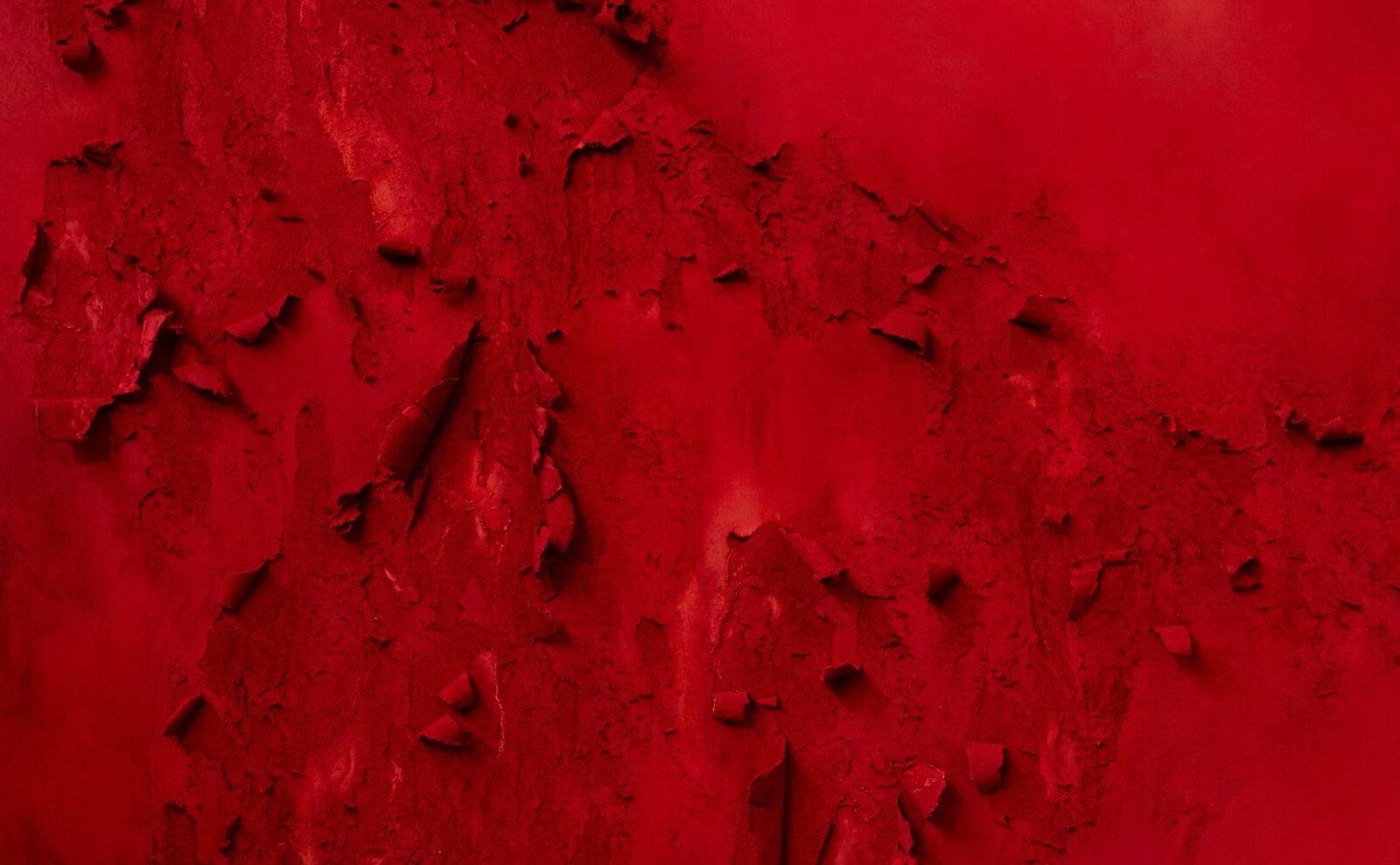
Ann Iren Buan. Hudsult
7 June – 17 August
Ann Iren Buan (b. 1984) lives and works in Oslo. In her practice, Buan explores the notions of decay and destruction through drawing and sculpture. Monumental, fragile, and haptic, her work investigates the materiality of drawing through a three-dimensional sculptural expression. Her sculptures appear to be in a continuous state of ruination, a fact further reinforced by her choice of fragile and vulnerable materials. Seemingly on the brink of collapse, the works insist on a continued existence and are often used as elements in new artworks in a cycle of decay and renewal.
Acts of care are often preceded by acts of violence. For her exhibition ‘Hudsult’ at OSL contemporary, Buan has applied a technique where she first weakens the paper by soaking it in water, before proceeding to rub and scratch the paper’s surface. This disrupts the material’s fibres, creating an open wound; a vulnerable surface that exposes the fragility of the paper. Following this destructive act, she tends to the wounds, covering them with dry pastel drawings, in clear and distinct hues of colour. For the artist, the colour itself is charged with emotions and qualities: they might be blustery, dry, or sorrowful, always stating a temper that evokes a certain set of emotions. Buan’s works are distinctly human; raw and rough, delicate and sensual. Her drawings remind us of the fragile chaos of our existence.
Bergen
Bergen Kunsthall
Toril Johannessen, detail view, 2024. Photo: Toril Johannessen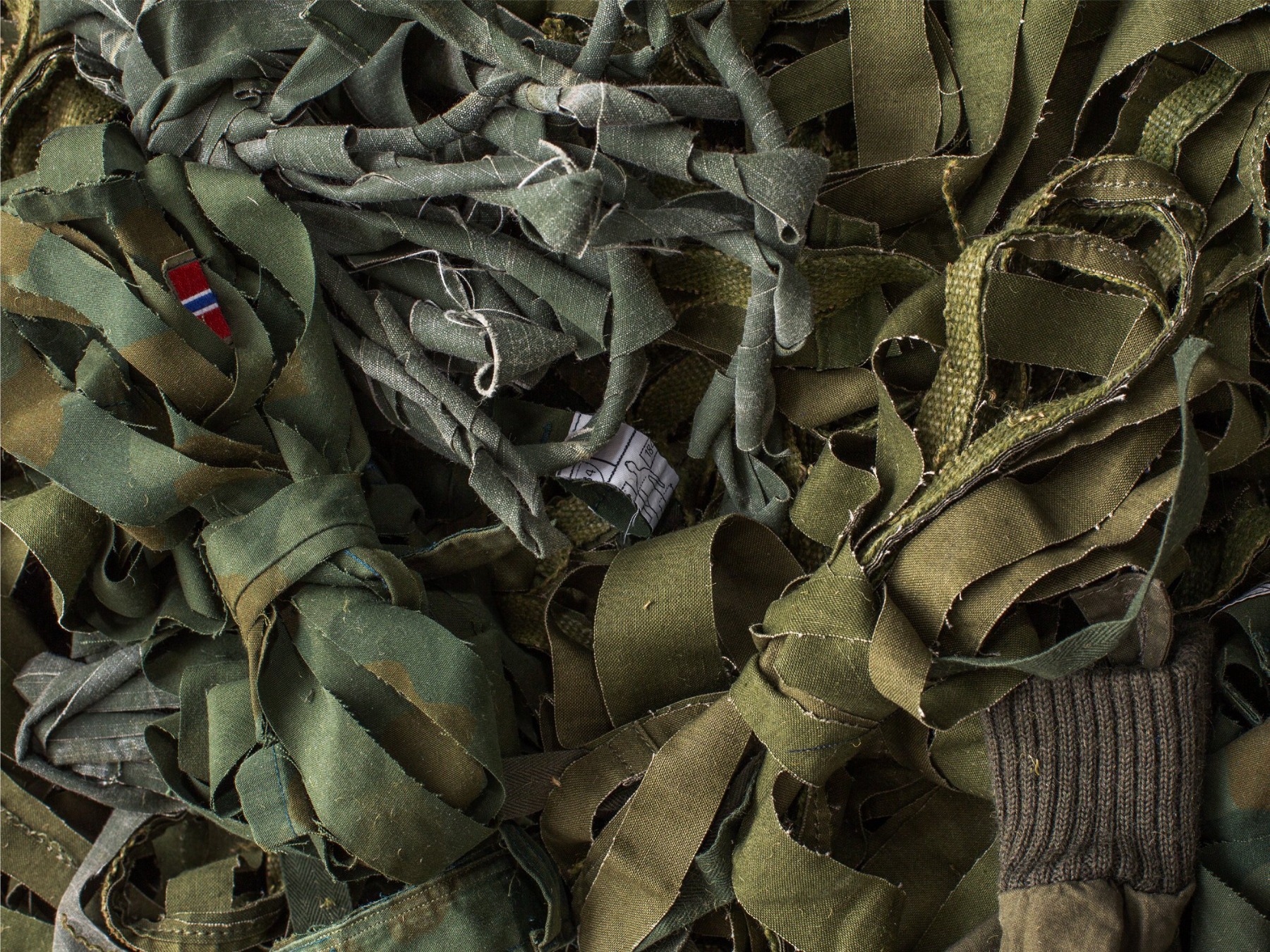
Toril Johannessen. The Festival Exhibition 2024: Deterrence and Reassurance
Until 11 August
Bergen Kunsthall presents Toril Johannessen as the Festival Artist 2024. The Festival Exhibition is considered the most important solo presentation for a Norwegian artist in the country and has been shown each summer since 1953, in parallel to the Bergen International Festival. Toril Johannessen will present a new installation across the four main galleries of Bergen Kunsthall, including a new large-scale woven carpet made from military textiles.
Information as material is central in many of Johannessen’s projects, including through the development of her own methods and datasets, that form the basis for works. Past works have made links between historical contexts and recent technological developments, looking at how historical factors interact and shape how we perceive and create reality. Her approach highlights the relationship between art, knowledge production and technology, giving visibility to social structures and events that otherwise remain hidden or publicly inaccessible.
The exhibition at Bergen Kunsthall is based on the artist’s current interest in military presence and the geopolitical situation in the High North. The conceptual framework for the exhibition is formed by the concept of deterrence and reassurance that forms the core of Norwegian security policies in the North, with a border to Russia and, previously, the Soviet Union. With Russia’s occupation of Crimea in 2014 and the war against Ukraine starting in 2022, the security landscape has changed significantly, also in Norway. Johannessen’s project documents and visualises the presence of the military in the landscape and the social imaginary, which seemingly belonged to the past but has, in fact, never disappeared.
Kode, Stenersen
Acelino Tuin Huni Kuin, Movimento dos Artistas Huni Kuin (MAHKU), «Kapenawë pukeni», 2022. MASP. Foto: Daniel Cabriel/MASP Opphavsrett: © Acelino Tuin Huni Kuin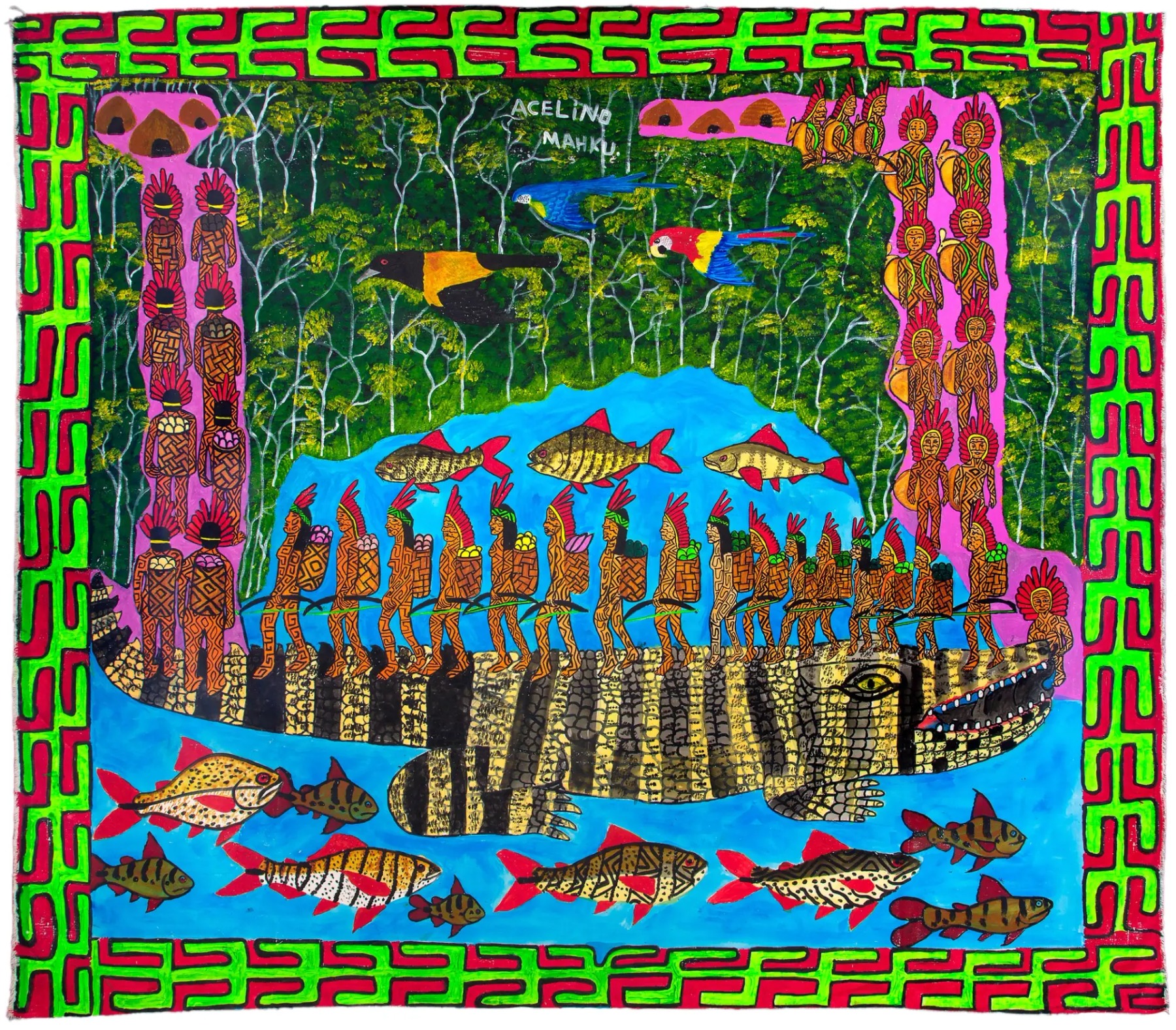
Indigenous Histories
Until 25 August
The exhibition presents different accounts of indigenous experience from South America, North America, Oceania, and the Nordic region, through art and visual culture, curated by artists and researchers who are indigenous or of indigenous descent. The show brings together around 285 works of multiple media, typologies, origins and periods, from the period before European colonization to the present, by more than 170 artists.
Despite its international scope and its temporal breadth, the project does not take an all-encompassing nor an encyclopedic approach – quite the contrary. In this respect, it is important to consider the meaning of the word “histórias” in Portuguese, which is rather different than “histories” in English. The term “histórias” encompasses both fiction and nonfiction, historical accounts as well as personal ones, of a public and private nature, on both micro and macro levels. In Norwegian, the term “historier” shares a similar dual significance, signifying both an interpretation of the past and a personal narrative.
As such, these terms possess a more polyphonic, speculative, open, incomplete, processual, and fragmented quality than the traditional notion of history.
Title image: Nastja Säde Rönkkö: Survival Guide for a Post-Apocalyptic Child (still), 2022. Costume design: Juha Vehmaanperä. Photo: Aake Kivalo
